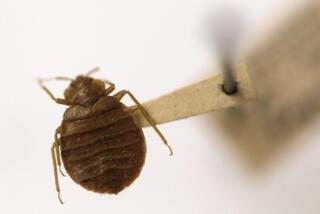Badgered by bedbugs: It’s hard to sleep tight
NEW YORK — When Bonnie Friedman first heard about New York’s burgeoning bedbug problem, she felt lucky to live in an upscale neighborhood.
“I remember thinking, ‘I’m so glad I live in Brooklyn Heights. I will never get a bedbug,’ ” Friedman said.
For the record:
12:00 a.m. Feb. 1, 2007 For The Record
Los Angeles Times Thursday February 01, 2007 Home Edition Main News Part A Page 2 National Desk 0 inches; 31 words Type of Material: Correction
Bedbugs: An article about bedbugs in Monday’s Section A said Dini Miller was an entomologist at Virginia Tech University. The name of the school is Virginia Polytechnic Institute and State University.
Her first bite came a few weeks later.
And as many others have learned, getting rid of the tiny intruders is often a months-long odyssey that requires equal parts detective work, obsessive-compulsive cleaning strategies and emotional healing.
“People in New York are used to cockroaches, where you have the exterminator come once but it doesn’t lay siege to your life,” said Friedman, a professor at New York University. “This does. Having them turns your life upside down.”
New Yorkers, especially those in the ritziest neighborhoods, are discovering that bedbugs aren’t the stuff of childhood fairy tales. They’re real, they pay no heed to socioeconomic boundaries, and they’re staging a comeback.
New York City apartment dwellers lodged 4,638 bedbug complaints in fiscal 2006, up from none three years earlier. Complaints ballooned 67% in the first half of this year from their pace a year earlier.
“There’s a new plague,” said Dini Miller, an entomologist at Virginia Tech University.
Bedbugs were virtually eradicated from the U.S. in the 1940s and 1950s, Miller said. The cause of their resurgence is not officially known, though theories include increased international travel in which the bugs hitch a ride on clothing or in luggage and decreased use of pesticides such as DDT.
Bedbugs are reddish-brown blood-sucking insects about a quarter of an inch long with a flat, oval shape. Drawn by body heat, they attack at night and inject an anesthetic that makes them virtually undetectable during their mealtime.
They feast for as much as 10 minutes at a time -- a galling fact to those hosting the extended feedings on their backs, necks and faces.
Bedbugs are as likely to infect a Park Avenue penthouse as a Lower East Side flophouse.
“I say ‘bedbugs’ and then I hear dead silence on the other end” of the phone, said Arnold Fishon, owner of AAA Abco Termite & Pest Control in Queens. “You could have told them they have cancer -- that’s the reaction they have. They say, ‘But I’m clean. I have a maid. I’m an attorney. I’m a doctor.’ ”
And bedbugs aren’t confined to New York.
Jeffrey Eisenberg, owner of Pest Away Exterminating Inc. in Manhattan, said a well-known Hollywood director begged him to treat his Malibu mansion.
“He said, ‘I’ll put you on a private jet. I’ll have you back the next day. Whatever it takes,’ ” Eisenberg recalled.
Bedbugs are fearsome foes -- tough to detect and tougher to wipe out.
First comes the sleuthing to determine whether bedbugs -- and not fleas or other pests -- are behind a victim’s splotchy bites and mottled skin. Identification is crucial because the common pesticides used for other insects often don’t work on bedbugs.
Next is the elaborate and costly eradication. Mattresses get tossed. Ditto couches, chairs and rugs. Clothes are washed and bagged. Extermination and replacement costs in many households easily total $5,000 and often run much higher.
The trickiest phase may come after the bedbugs are gone -- or appear to be. Because victims typically don’t know where the intruders came from, they live in fear of reinfestation.
“It has changed my life,” said a tearful Long Island woman who has moved several times to avoid them. “I’ve completely isolated myself. I won’t go out anymore. I won’t go to the movies anymore. My friends who don’t have them don’t understand.”
Not everyone has such a reaction, but some say they still struggle to live normally.
“I went to a cocktail party last week,” said an Upper East Side business executive, “and the staff took everybody’s coat and threw them on the bed. I was scared but I couldn’t say anything.”
Friedman is hopeful that she’s over the hump. She has yet to replace her couch, but after four extermination treatments she hasn’t been bitten since early December.
Still, it’s too early to declare victory.
“There’s this terror that you haven’t gotten rid of them,” she said.
*
(BEGIN TEXT OF INFOBOX)
A bug’s life
The admonition “Don’t let the bedbugs bite” has taken on new urgency as the wingless insects have made their way back into the lives of New Yorkers. Some facts about the storied pest, known formally as Cimex lectularius:
Habitat: Narrow crevices, especially the kind in floors, walls, bed frames and mattresses -- all readily found in homes, hotels and dorms.
Diet: Warm blood, most often taken while their food source -- animal or human -- sleeps.
Travel: Frequent travelers, hitching rides locally and internationally on clothing and bedding, in boxes and luggage.
Looks: Reddish brown or brown, flattened from top to bottom. Eggs are the size of tiny seeds; adults about a quarter of an inch long.
Life cycle: Under typical circumstances, the hardy insect lives for about a year -- and can go for months without feeding. A bedbug can lay 200 to 250 eggs in its lifetime.
Source: Harvard School of Public Health, University of California Agriculture and Natural Resources
More to Read
Sign up for Essential California
The most important California stories and recommendations in your inbox every morning.
You may occasionally receive promotional content from the Los Angeles Times.










